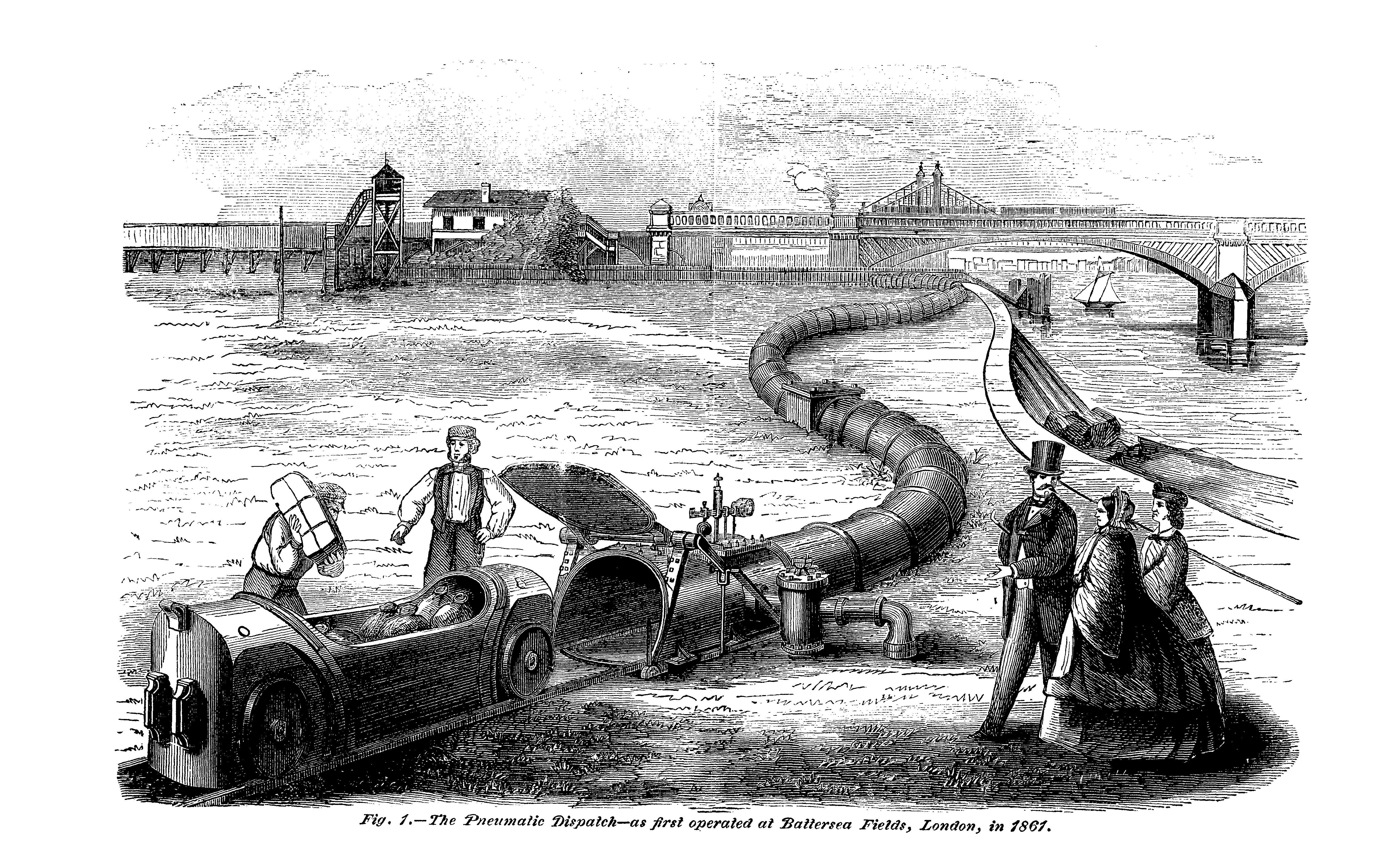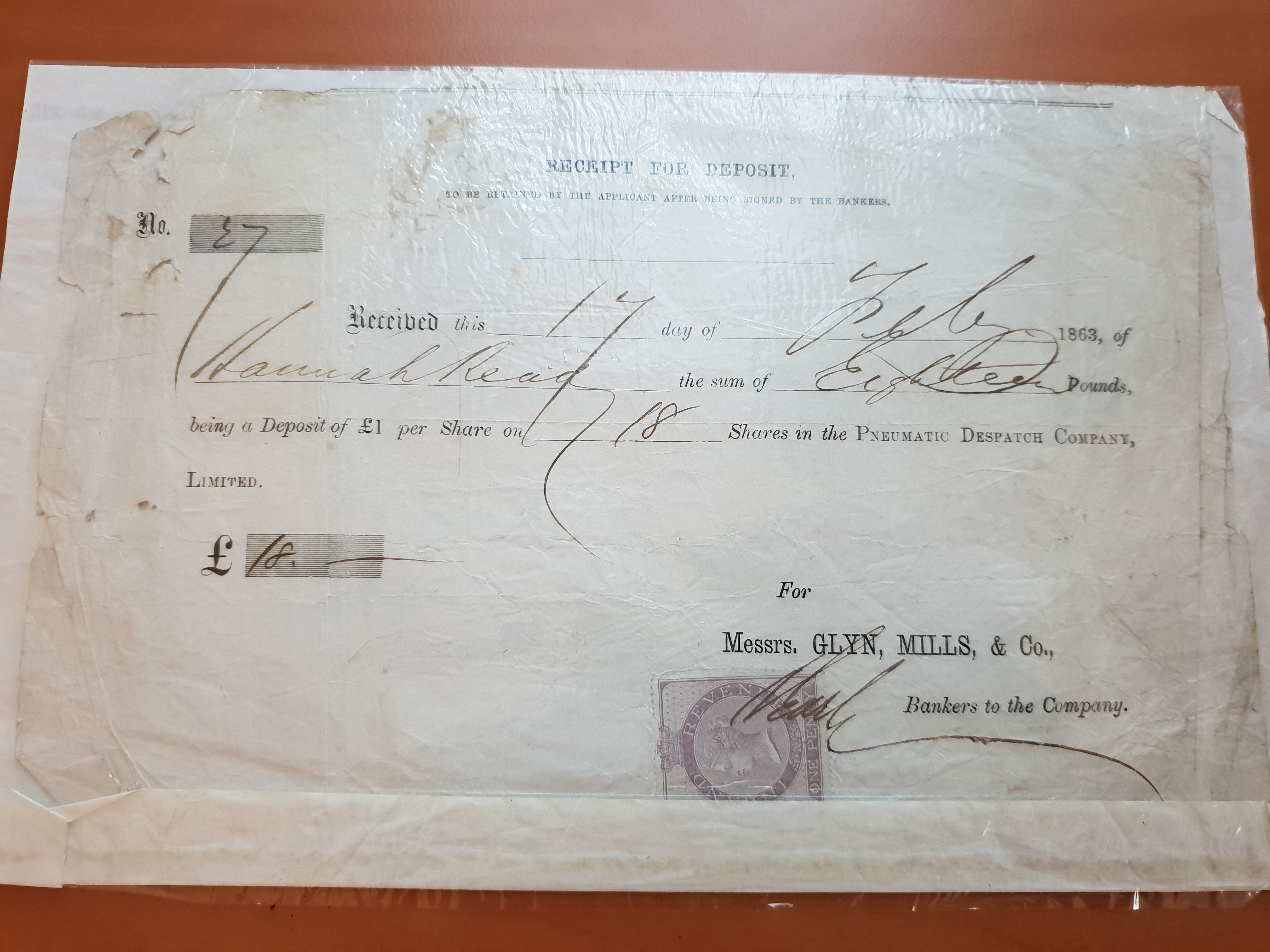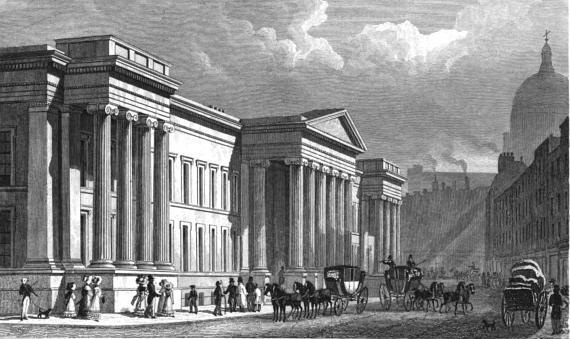London Pneumatic Despatch Company on:
[Wikipedia]
[Google]
[Amazon]
 The London Pneumatic Despatch Company (also known as the London Pneumatic Dispatch Company) was formed on 30 June 1859, to design, build and operate an underground railway system for the carrying of mail, parcels and light freight between locations in London. The system was used between 1863 and 1874.
The London Pneumatic Despatch Company (also known as the London Pneumatic Dispatch Company) was formed on 30 June 1859, to design, build and operate an underground railway system for the carrying of mail, parcels and light freight between locations in London. The system was used between 1863 and 1874.
 Sir
Sir
 A permanent line of narrow gauge was constructed between
A permanent line of narrow gauge was constructed between  Work started on a
Work started on a  Construction restarted in 1868, and it was completed to St. Martin's le Grand (for the General Post Office) in 1869. Capsules from the General Post Office reached Newgate Street within 17 minutes, at speeds of up to 60 mph.
The Post Office made several trials of the system, but there were not substantial time savings to be made, and by 1874, the Post Office abandoned its use, and the company went into liquidation in 1875. The Edinburgh Evening News reported in 1876 that the trucks containing the parcels continually stuck in the tunnels, and this was the reason for the failure of the company.
In late 1921, an agreement was reached between the Pneumatic Despatch Company and the Postmaster General for the sale (for £7,500) of the remaining infrastructure of "the tube" to the Postmaster General. The agreement recognised that "the Company has not for many years past worked the tube and the same is not now in working order" and that various persons had made unauthorised breaches in the tube as originally constructed. The agreement was confirmed by the Post Office (Pneumatic Tubes) Act 1922,12 & 13 Geo. 5. Chapter 43. which also repealed enactments from 1859, 1864 and 1872 authorising the company.
Construction restarted in 1868, and it was completed to St. Martin's le Grand (for the General Post Office) in 1869. Capsules from the General Post Office reached Newgate Street within 17 minutes, at speeds of up to 60 mph.
The Post Office made several trials of the system, but there were not substantial time savings to be made, and by 1874, the Post Office abandoned its use, and the company went into liquidation in 1875. The Edinburgh Evening News reported in 1876 that the trucks containing the parcels continually stuck in the tunnels, and this was the reason for the failure of the company.
In late 1921, an agreement was reached between the Pneumatic Despatch Company and the Postmaster General for the sale (for £7,500) of the remaining infrastructure of "the tube" to the Postmaster General. The agreement recognised that "the Company has not for many years past worked the tube and the same is not now in working order" and that various persons had made unauthorised breaches in the tube as originally constructed. The agreement was confirmed by the Post Office (Pneumatic Tubes) Act 1922,12 & 13 Geo. 5. Chapter 43. which also repealed enactments from 1859, 1864 and 1872 authorising the company.
London’s Lost Pneumatic Railway: The World’s 2nd Oldest Underground
London's Victorian Hyperloop
Pneumatics Pipeline transport Postal system of the United Kingdom Postal history of the United Kingdom London Post Office Railway Industrial railways in England Subterranean London History of rail transport in London 2 ft gauge railways in England British companies established in 1859 British companies disestablished in 1875 1859 establishments in England Railway companies established in 1859 Railway companies disestablished in 1875
 The London Pneumatic Despatch Company (also known as the London Pneumatic Dispatch Company) was formed on 30 June 1859, to design, build and operate an underground railway system for the carrying of mail, parcels and light freight between locations in London. The system was used between 1863 and 1874.
The London Pneumatic Despatch Company (also known as the London Pneumatic Dispatch Company) was formed on 30 June 1859, to design, build and operate an underground railway system for the carrying of mail, parcels and light freight between locations in London. The system was used between 1863 and 1874.
Background
Rowland Hill
Sir Rowland Hill, KCB, FRS (3 December 1795 – 27 August 1879) was an English teacher, inventor and social reformer. He campaigned for a comprehensive reform of the postal system, based on the concept of Uniform Penny Post and his soluti ...
of the General Post Office
The General Post Office (GPO) was the state postal system and telecommunications carrier of the United Kingdom until 1969. Before the Acts of Union 1707, it was the postal system of the Kingdom of England, established by Charles II in 1660. ...
commissioned two engineers to investigate the feasibility of a pneumatic tube-based system between the General Post Office and the West District Central Post Office. In 1855 and 1856 they reported favourably but there would be significant cost. The scheme was not progressed.
In 1859 Thomas Webster Rammell and Josiah Latimer Clark proposed an underground tube network in central London "for the more speedy and convenient circulation of despatches and parcels".
The company was founded in 1859 with offices at 6 Victoria Street, Westminster. Capital of £150,000 was sought through 15,000 shares at £10 each. The company's directors were its chairman Richard Temple-Grenville, 3rd Duke of Buckingham and Chandos
Richard Plantagenet Campbell Temple-Nugent-Brydges-Chandos-Grenville, 3rd Duke of Buckingham and Chandos (10 September 1823 – 26 March 1889), styled Earl Temple until 1839 and Marquess of Chandos from 1839 to 1861, was a British soldier, poli ...
, deputy chairman Mark Huish
Captain Mark Huish (9 March 1808 – 18 January 1867) was an English railway manager. He is best known for his term as General Manager of the London & North Western Railway, a position he held for 12 years, beginning from the Company's formation ...
, Thomas Brassey
Thomas Brassey (7 November 18058 December 1870) was an English civil engineering contractor and manufacturer of building materials who was responsible for building much of the world's railways in the 19th century. By 1847, he had built about o ...
, Edwin Clark, the Hon. William Napier, John Horatio Lloyd
John Horatio Lloyd (1 September 1798 – 17 July 1884) was an English barrister and Liberal MP for Stockport from 1832 to 1835.
Background
He was born the son of John Lloyd, attorney and Town Clerk of Stockport, and Mary Lott.
He was educated ...
, William Henry Smith and Sir Charles Henry John Rich.
With initial funding of £25,000 (£ in ), the company tested the technology and constructed a pilot route at the Soho Foundry
Soho Foundry is a factory created in 1775 by Matthew Boulton and James Watt and their sons Matthew Robinson Boulton and James Watt Jr. at Smethwick, West Midlands, England (), for the manufacture of steam engines. Now owned by Avery Weigh-Tr ...
of Boulton and Watt
Boulton & Watt was an early British engineering and manufacturing firm in the business of designing and making marine and stationary steam engines. Founded in the English West Midlands around Birmingham in 1775 as a partnership between the Engli ...
in Birmingham. The first full-scale trial was at Battersea
Battersea is a large district in south London, part of the London Borough of Wandsworth, England. It is centred southwest of Charing Cross and extends along the south bank of the River Thames. It includes the Battersea Park.
History
Batter ...
during the summer of 1861. A single tube was installed, 452 yards long, with curves of up to radius and gradients of up to 1 in 22. narrow gauge
A narrow-gauge railway (narrow-gauge railroad in the US) is a railway with a track gauge narrower than standard . Most narrow-gauge railways are between and .
Since narrow-gauge railways are usually built with tighter curves, smaller structu ...
track was cast inside the tube. Wheeled capsules were fitted with vulcanised rubber flaps to make an air seal. Power was provided by a 30 horse-power steam engine
A steam engine is a heat engine that performs mechanical work using steam as its working fluid. The steam engine uses the force produced by steam pressure to push a piston back and forth inside a cylinder. This pushing force can be trans ...
with a diameter fan. Single capsules weighed up to 3 tonnes, and achieved speeds up to 40 mph (60 km/h).
Operation
 A permanent line of narrow gauge was constructed between
A permanent line of narrow gauge was constructed between Euston railway station
Euston railway station ( ; also known as London Euston) is a central London railway terminus in the London Borough of Camden, managed by Network Rail. It is the southern terminus of the West Coast Main Line, the UK's busiest inter-city railw ...
and the North West District Post Office in Eversholt Street, a distance of approximately a third of a mile. The line was tested from 15 January 1863, and operation started on 20 February 1863. A capsule conveying up to 35 bags of mail could make the short journey between terminals in one minute. Thirteen journeys were operated each day, with a daily operating cost of £1 4s 5d. The Post Office was charged a nominal fee for use of the service, presumably to encourage them to accept the technology.
A journalist made a report on the first scheme at Euston:
The company sought to develop further lines within London, and attempted to raise an additional £125,000 (£ in ), of capital. The prospectus proposed a network of lines between "points so important that it is unnecessary to dwell upon the magnitude of the traffic that must naturally arise between them". The first line was to have been a route linking the Camden Town and Euston (Square) stations of the London and North Western Railway.
 Work started on a
Work started on a narrow gauge
A narrow-gauge railway (narrow-gauge railroad in the US) is a railway with a track gauge narrower than standard . Most narrow-gauge railways are between and .
Since narrow-gauge railways are usually built with tighter curves, smaller structu ...
line from Euston to Holborn in September 1863.''Atmospheric Railways'', David and Charles Hadfield, 1967. The tubes were constructed by the Staveley Coal and Iron Company. The first 'trains' ran on 10 October 1865 after a demonstration in which the chairman, Richard Temple-Grenville, 3rd Duke of Buckingham and Chandos
Richard Plantagenet Campbell Temple-Nugent-Brydges-Chandos-Grenville, 3rd Duke of Buckingham and Chandos (10 September 1823 – 26 March 1889), styled Earl Temple until 1839 and Marquess of Chandos from 1839 to 1861, was a British soldier, poli ...
, travelled from Holborn to Euston in one of the capsules.
Another line from Holborn to Gresham Street via the General Post Office on St Martin's le Grand was under construction in 1865. By the time of the 1866 financial crisis caused by the Overend, Gurney and Company
Overend, Gurney & Company was a London wholesale discount bank, known as "the bankers' bank", which collapsed in 1866 owing about £11 million, equivalent to £ million in . The collapse of the institution triggered a banking panic.
History Ear ...
collapse, a ⅜ mile tube from Holborn to Hatton Garden had been constructed. Total expenditure so far was £150,000 (£ in ).
 Construction restarted in 1868, and it was completed to St. Martin's le Grand (for the General Post Office) in 1869. Capsules from the General Post Office reached Newgate Street within 17 minutes, at speeds of up to 60 mph.
The Post Office made several trials of the system, but there were not substantial time savings to be made, and by 1874, the Post Office abandoned its use, and the company went into liquidation in 1875. The Edinburgh Evening News reported in 1876 that the trucks containing the parcels continually stuck in the tunnels, and this was the reason for the failure of the company.
In late 1921, an agreement was reached between the Pneumatic Despatch Company and the Postmaster General for the sale (for £7,500) of the remaining infrastructure of "the tube" to the Postmaster General. The agreement recognised that "the Company has not for many years past worked the tube and the same is not now in working order" and that various persons had made unauthorised breaches in the tube as originally constructed. The agreement was confirmed by the Post Office (Pneumatic Tubes) Act 1922,12 & 13 Geo. 5. Chapter 43. which also repealed enactments from 1859, 1864 and 1872 authorising the company.
Construction restarted in 1868, and it was completed to St. Martin's le Grand (for the General Post Office) in 1869. Capsules from the General Post Office reached Newgate Street within 17 minutes, at speeds of up to 60 mph.
The Post Office made several trials of the system, but there were not substantial time savings to be made, and by 1874, the Post Office abandoned its use, and the company went into liquidation in 1875. The Edinburgh Evening News reported in 1876 that the trucks containing the parcels continually stuck in the tunnels, and this was the reason for the failure of the company.
In late 1921, an agreement was reached between the Pneumatic Despatch Company and the Postmaster General for the sale (for £7,500) of the remaining infrastructure of "the tube" to the Postmaster General. The agreement recognised that "the Company has not for many years past worked the tube and the same is not now in working order" and that various persons had made unauthorised breaches in the tube as originally constructed. The agreement was confirmed by the Post Office (Pneumatic Tubes) Act 1922,12 & 13 Geo. 5. Chapter 43. which also repealed enactments from 1859, 1864 and 1872 authorising the company.
Artifacts
Two of the original vehicles survive, having been recovered in 1930, one in theMuseum of London
The Museum of London is a museum in London, covering the history of the UK's capital city from prehistoric to modern times. It was formed in 1976 by amalgamating collections previously held by the City Corporation at the Guildhall, London, Gui ...
and the other in the National Railway Museum
The National Railway Museum is a museum in York forming part of the Science Museum Group. The museum tells the story of rail transport in Britain and its impact on society. It is the home of the national collection of historically significant r ...
at York.
See also
*London Post Office Railway
The Post Office Railway, is a narrow gauge, driverless underground railway in London that was built by the Post Office with assistance from the Underground Electric Railways Company of London, to transport mail between sorting offices. Inspire ...
References
{{ReflistExternal links
London’s Lost Pneumatic Railway: The World’s 2nd Oldest Underground
London's Victorian Hyperloop
Pneumatics Pipeline transport Postal system of the United Kingdom Postal history of the United Kingdom London Post Office Railway Industrial railways in England Subterranean London History of rail transport in London 2 ft gauge railways in England British companies established in 1859 British companies disestablished in 1875 1859 establishments in England Railway companies established in 1859 Railway companies disestablished in 1875